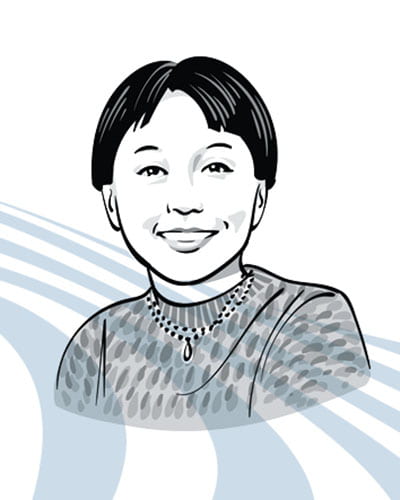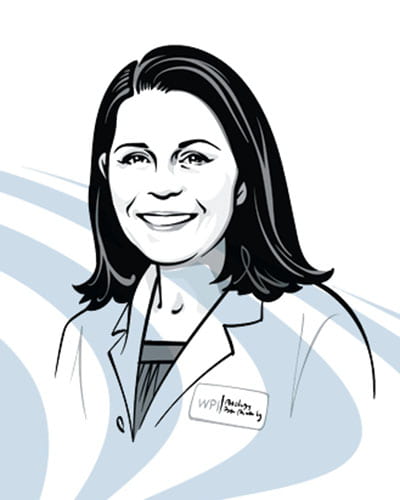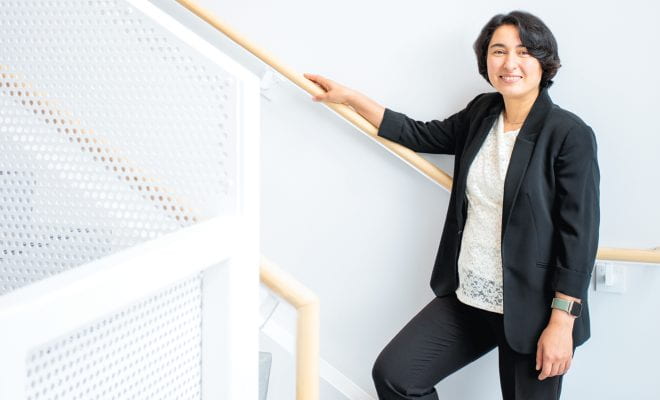Sensing the Living Breath
Electrical engineer Ulkuhan Guler has an ambitious goal: creating a small, smart, skin patch that collects critical measures of respiration.
Read StoryIn addition to Assistant Professor Ulkuhan Guler, three other WPI faculty members recently received the National Science Foundation’s CAREER grant, which supports researchers during the early stages of their academic careers. Since 2012, 24 WPI researchers have received the prestigious award.
“The NSF awards received this past year by four of our colleagues confirm one of the defining characteristics of our institution’s culture: excellence in combining research and education,” says Vice Provost for Research Bogdan Vernescu. “This past academic year has not only been a record year for CAREER awards, it has also been the best year in terms of research expenditures, which surpassed—for the first time—the $40 million mark.”
Min Wu, Assistant Professor in the Department of Mathematical Sciences
$450,000 CAREER grant to develop mathematical models describing how secretions and mechanical forces shape the growth of elongated plant cells
The five-year project will focus on mathematical modeling of filamentous cell wall growth, which could lead to insights about plants and fungi that impact agriculture and human health, says Wu.
“The way that filamentous walled cells grow is poorly understood, and it is challenging to observe and measure the biological activity with experimental approaches alone,” she says. “Mathematical models can bridge this knowledge gap. Models could lead to a better understanding of how plant root hairs reach into soil for moisture and nutrients and how fungi that cause illness could be attacked.”
Cell filaments such as juvenile-stage moss cells maintain their growth at the tip and through a process known as exocytosis. During exocytosis, materials inside a cell travel through the cell membrane and lay down deposits on the exterior of the cell.

The project expands on Wu’s previous research, which has used mathematics to analyze biological processes, such as wound healing and tumor growth. She also has modeled the development of large-scale living tissues.
Read more about Wu’s research.
Erin Ottmar, Associate Professor in the Department of Social Science and Policy Studies
$700,000 CAREER grant to develop technology that will help middle school teachers better understand when and how students are succeeding or struggling while learning algebra

Ottmar will design and develop real-time artificial intelligence tools for digital mathematics platforms so that teachers can better detect, assess, and predict the math strategies and knowledge of their students.
“It’s difficult for busy teachers to quickly and efficiently identify the problem-solving strategies that students are using or failing to use as they learn algebra,” Ottmar says. “It’s a challenge that accelerated during the COVID-19 pandemic as many schools moved to online classes. The goal of this project is to use data mining to develop tools that will provide useful information to teachers in real time to help them better instruct and guide students.”
To develop indicators of mathematical strategies and knowledge, Ottmar will use data collected during a large study from 1,300 students who played a digital math game, From Here to There, that uses Graspable Math technology.
Graspable Math, which Ottmar helped develop with previous funding from the U.S. Department of Education, enables students to dynamically solve math problems on a screen, such as a tablet or laptop computer, by dragging or clicking on numbers to move them around while solving problems. The technology alerts students if they make an incorrect move and logs all students’ actions and mathematical steps. Graspable Math is developed by Graspable Inc. of Bloomington, Ind.
During the project, Ottmar will co-design new tools with teachers, pilot the tools in classrooms, and launch a website with free public access to the tools for students, teachers, administrators, and researchers. WPI undergraduate and graduate students, as well as teachers and students from local schools, will participate in the research.
Read more about Ottmar’s research.
Amity Manning, Associate Professor in the Department of Biology and Biotechnology
$1.1 Million CAREER grant to determine the factors influencing a critical piece of cellular machinery during normal cell division
The five-year project will focus specifically on histone modifications in a dividing cell and how they recruit proteins to help with the process of cell division. More broadly, the project will answer questions about a fundamental cellular process that impacts how organisms grow, mature, and maintain life.
“Proper cell division is critical for all living organisms,” says Manning, “Cell division, however, must be precise and accurate. Understanding the role of histone modifications in the equal division of genetic material when a cell divides is going to have implications for all normal processes that require cell proliferation.”
Manning will define the cellular mechanisms that enrich an enzyme called Suv420 on chromosomes, which are molecules in the cell nucleus that contain genetic code. Suv420 modifies a histone protein, H4K20me3, that is involved in organizing chromosomes. H4K20me3 is enriched on chromosomes near a central point called the centromere. Suv420 and H4K20me3 are thought to play a role in sorting chromosomes from a parent cell into new daughter cells and preventing chromosome sorting errors that could occur during cell division. Manning also will define the role that other histone modifications play in the composition and function of centromeres.

The project builds on Manning’s previous research exploring molecular mechanisms that regulate cell division. She is working to define the role of retinoblastoma protein in cell division errors and to help develop computational models that account for the forces that influence cell division.
As part of the project, Manning will add material to her undergraduate biology courses to enhance scientific literacy among students, and she will participate in co-op and internship programs for high school students that are aimed at encouraging underrepresented populations to pursue careers in science.
Read more about Manning’s research.

Electrical engineer Ulkuhan Guler has an ambitious goal: creating a small, smart, skin patch that collects critical measures of respiration.
Read Story